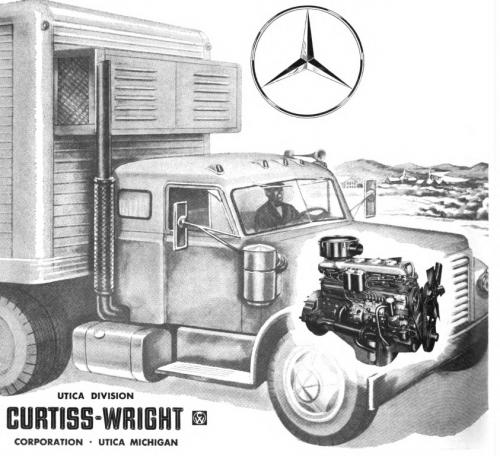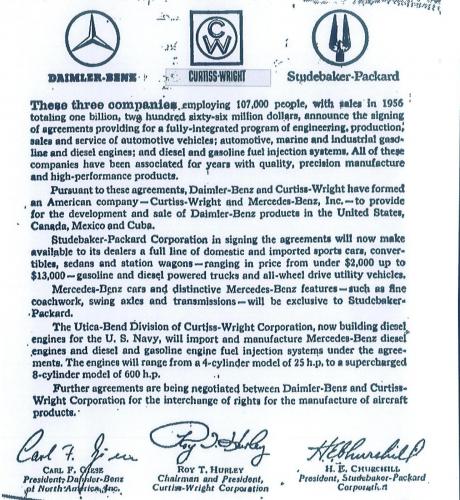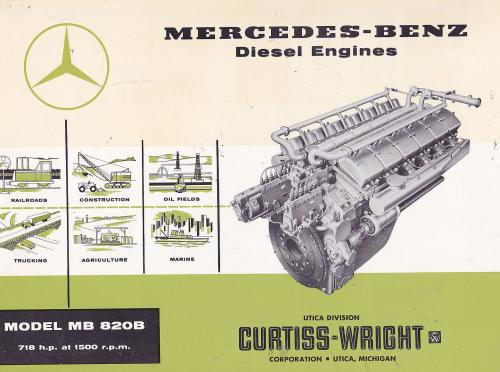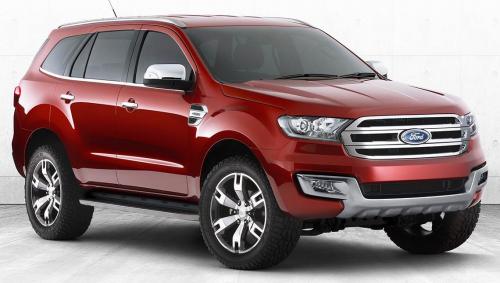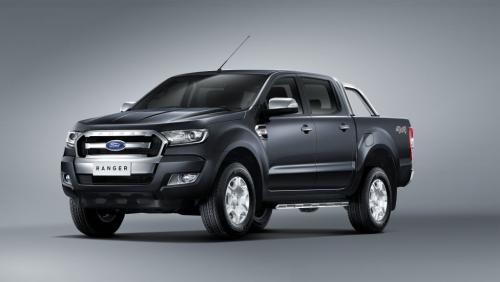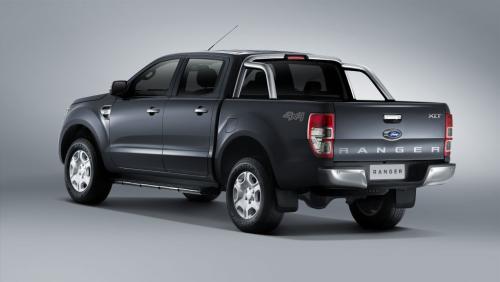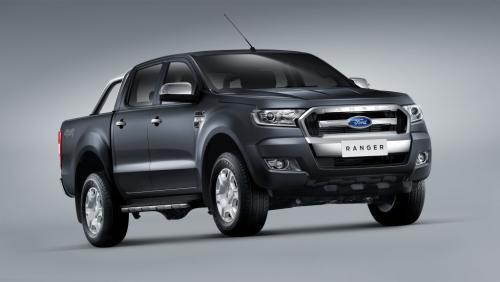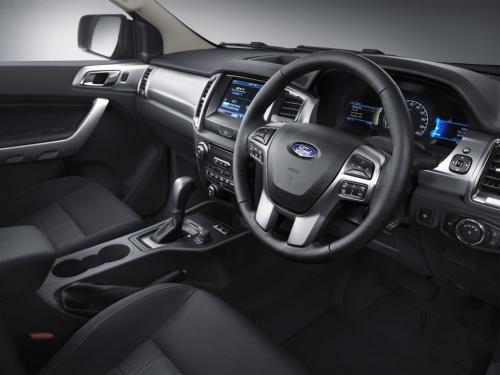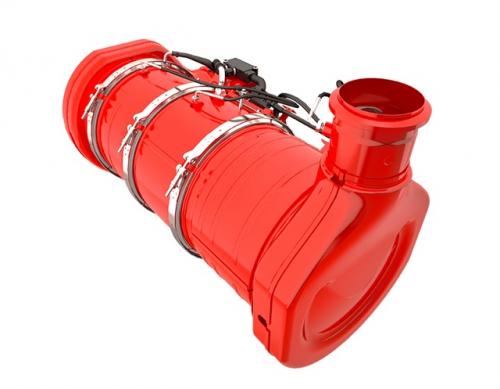
kscarbel2
Moderator-
Posts
18,886 -
Joined
-
Days Won
114
Content Type
Profiles
Forums
Gallery
Events
Blogs
BMT Wiki
Collections
Store
Everything posted by kscarbel2
-
In 1956, Curtiss-Wright agreed to loan $35 million to financially troubled Studebaker-Packard and provide management services to the automaker under contract for three years. Under Curtiss-Wright's guidance, Studebaker-Packard sold the old Detroit Packard plant and returned the then-new Packard plant to its lessor, Chrysler. During the 1950s, a weak sales network prevented Mercedes-Benz from penetrating the U.S. car market. Then in 1957, under the guidance of Curtiss-Wright head Roy Hurley, Studebaker-Packard signed an agreement with Daimler-Benz making the US carmaker the exclusive distributor for Mercedes-Benz cars, commercial trucks and Unimog utility vehicles in the U.S. and Canada. The agreement also stipulated that the Utica-Bend Division of Curtiss-Wright Corporation, then producing diesel engines for the U.S. Navy, would import and manufacture Mercedes-Benz diesel engines ranging from 25 to 600 horsepower, as well as fuel injection systems. Studebaker-Packard formed a subsidiary, Mercedes-Benz Sales, Inc., which sold and serviced Mercedes-Benz cars through select franchised dealers. Following the Packard nameplate's demise in 1959, Studebaker-Packard became Studebaker Corporation in 1962 and continued as Mercedes-Benz’s exclusive U.S. distributor until February 1965, when Daimler-Benz bought Studebaker’s Mercedes-Benz Sales Inc. subsidiary including the distribution rights for the United States and Canada for approximately $9 million. .
-
Ford Press Release / March 24, 2015 Related reading: http://www.bigmacktrucks.com/index.php?/topic/37730-ford-introduces-all-new-mid-size-everest-suv/?hl=everest http://www.bigmacktrucks.com/index.php?/topic/39373-ford-everest-taming-the-terrain/?hl=everest .
-
Teardrop tests reveal that as much as 30.3% could be saved running at 85kmp/h (53mph), and even at slower speeds, cash can be saved. Following the successful integration of box van Teardrop trailers into their fleet in 2007, DHL now has over 200 in use. To date, fuel saving figures have averaged over 12% in comparison to existing trailers.
-
Heavy Duty Trucking / March 23, 2015 The Mid-America Trucking Show will be held this week, from March 26-28, at the Kentucky Expo Center in Louisville, Ky. Organizers are expecting possible record attendance. MATS is an annual heavy-duty trucking industry show that brings in more than 70,000 attendees and over 1,000 exhibitors showcasing the latest products and services. Organizers have said there is a good chance of breaking the previous attendance record of 80,972, set in 2012, according to published reports. For attendees, there are panels and other opportunities to learn about current topics affecting the trucking industry. The event also provides an opportunity for members of the industry to meet and network. MATS is host to a wide variety of special events and educational seminars for industry members. The day before the show opens, the sold-out Fleet Forum will be produced and hosted by Heavy Duty Trucking and Fleet Owner on March 25. As part of a full afternoon program, HDT's 2015 "Truck Fleet Innovators" will be officially honored for the award and participate in a panel discussion. There is also a Ride-N-Drive event offering test drives of new trucks equipped with the latest technological advances in braking, driveline, engine, suspensions and transmissions. The 26th annual PKY Truck Beauty Championship will feature a large grouping of show trucks vying for honors in the beauty competition in Lot J behind the west wing of the Expo Center. Every day, there will be discussions and seminars given by fleets, manufacturers and industry associations on several topics related to regulations, driver retention, safety, technology and health. Top equipment and product manufacturers will have booths on display as well as some special events planned. For complete information on the event including announcements and schedules, go to the Mid-America Trucking Show Website or download the official MATS 2015 app on the Apple App Store or Google Play.
-
Truck News / March 23, 2015 Bolt-on devices have improved trailer aerodynamics. But is it time for some more radical thinking, including the reshaping of the box itself? It seems like putting lipstick on a pig, taking that old-as-the-hills, brick-shaped dry van and bolting on aerodynamic devices like side skirts, boat tails and scoops to reduce aerodynamic drag and fuel consumption. They are effective, but are such disguises the only way forward? Can or should the shape of the trailer be improved? The short answers are “yes,” and “over my dead body.” Tapering the rear of the trailer reduces drag; airflow management at the rear of the trailer is one of four critical areas of a tractor-trailer identified for aerodynamic improvements. Users, however, are wary of reduced cargo capacity, smaller or inconveniently positioned rear doors or complicated trailer loading that might result from changing the shape of the box. The long answer is “yes, but it will likely take regulatory changes.” Changes to trailer design are, in fact, predicted in the new US Environmental Protection Agency’s Phase 2 greenhouse gas and fuel efficiency standards, which will be finalized in 2016. “I suspect that the EPA change will result in changes to trailer shapes,” predicts Brian McAuliffe, a research officer in the aerodynamics laboratory, at the National Research Council Canada (NRC). He is also the thrust lead for the Enhanced Aerodynamics Performance thrust of the Fleet Forward 2020 program, which brings together experts and facilities from across NRC to offer technical R&D solutions to the transportation industry. Under Fleet Forward 2020, NRC does aerodynamic testing and evaluations for OEMs and government regulators, and supports Canadian companies in the development of their technologies. Currently, marketed trailer aerodynamic improvements fit into two main categories: bold shape changes like those seen in England, and North American successes in dolling up the pig without altering cubic volume or the rear doors. Possibly the most advanced expression of the technologies in the latter category is a Cummins-Peterbilt demonstration tractor-trailer, developed with support from the SuperTruck program, initiated by the U.S. Department of Energy. In early 2014 Peterbilt Motors Company and Cummins announced that their SuperTruck managed 10.7 mpg in real-world driving conditions. Although they made many changes from tip to tail, including a lot of engine and transmission doctoring, Cummins and Peterbilt did not change the basic trailer shape. It did, however, push the designs of aerodynamic add-ons, big achievers and small, to wring more mileage out of the demonstration rig. “A key goal of the project was to have no negative ripple-effects on a shipper’s operations. We set out to design a vehicle that can be seamlessly introduced into (fleets) without disrupting other areas of operations. Our research indicated that retaining the traditional box-van style of the trailer was essential to real-world adoption of the technologies we needed to develop,” explains Ken Damon, Peterbilt manager, vehicle performance group. The real world has a way of putting a choke chain on innovation, although it can be persuaded to change. Take two companies in Britain, the Cartwright Group (http://www.cartwright-group.co.uk/cheetah_fastback.asp) and Don-Bur (http://www.donbur.co.uk/eng/products/aerodynamic_teardrop_trailers_rigids.php). They manufacture curvaceous trailers with rounded edges and sloping roofs that reduce drag and fuel consumption. A sloping rear roof modifies the air wake, reducing suction at the rear of the trailer that causes aerodynamic drag. Cartwright’s Cheetah has a conventional, straight-line roof at the front, but the rear half slopes down several inches. Another of its designs slopes down at the front for smooth airflow from the cab roof and over the trailer. Cartwright reports fuel savings of up to 12% over a regular dry van. Don-Bur’s Teardrop 2.0 trailer is tapered both in the front and at the rear. The company reports an 11.3% fuel saving and no loss – in fact, an increase – in cubic capacity. Despite the acceptance of the Teardrop and Cheetah in the U.K., no such trailers grace our highways. The closest thing to them, and by close, I mean far, is the second version of a 2011 design collaboration among paper and packaging giant Cascades, trailer manufacturer Manac, FPInnovations and the University of Laval. This modified trailer sported a high-radius curve in the horizontal top front edge of the roof, rounded side edges up front, and a six-inch drop in the rear 10 feet of the roof. It failed to yield any fuel savings. Subsequently, however, Manac and Cascades built a second trailer, this time from scratch, that it has been road-testing since 2014 between Quebec and Ontario. Fuel records suggest a 3% fuel saving. Those rounded front edges help reduce aerodynamic drag. “Rounded corners in the front go a long ways. The wind is smoothly guided around the corner and stays attached to the vehicle,” McAuliffe says. While not really changing the trailer shape, smoothing the trailer underbody may hold promise in reducing aerodynamic drag. “My suspicion is that the biggest gains with current modern aero tractors are the underbody and base (back of the vehicle),” McAuliffe says. A more radical idea is a variable-size trailer. A 2012 NRC technical report prepared for Transport Canada makes brief mention of a retractable trailer concept. Fully loaded, the trailer is a regular-sized dry van. But when it is less than full, the trailer can be partially collapsed to make it shorter. Attributed to a British Columbia designer by the name of Brad Bennett, the upper walls and roof would winch up and down on an electric gear track assembly. Bennett reportedly claims that trucks, especially short-haul trucks, often travel from 15-50% empty over the distance of their trips. This raises a tough question about trailer design. “The challenging bit is how do you modify a box to be more aerodynamic but not to lose space and stay within the dimensions you are allowed,” asks Don Moore, executive director, Canadian Transportation Equipment Association. “Do we really know whether we are using all this space?” Do carriers really need the full trailer volume? Is there an acceptable trade-off between volume, revenue and fuel cost? “I would hope carriers have a pretty good grip on this,” Moore adds. It is revealing that whenever designers are asked to sketch an aerodynamic trailer, they obligingly dash off a piece of truck porn straight from the pages of a 1960s Popular Mechanics magazine. Daimler, another SuperTruck program participant, did just that in a press release about its SuperTruck plans. Its concept drawing features a tractor shaped like a bottlenose dolphin’s head, and a smartly tapered trailer. The overall effect is reminiscent of the Art Deco-style locomotive experiments of the 1930s. In North America, however, these beauties have never been driven off the pages and into regular service. Daimler declined to discuss its trailer modifications for this article. The industry will have to wait till mid-2015 to hear the results of its testing, and whether its SuperTruck trailer deviates from that brick shape. The early aerodynamic devices of the 1970s and 1980s met with resistance and the industry might not yet be willing to entertain changes in the dry box trailer shape. But GHG Phase 2 will include trailers. “There are a lot of discussions in the US between EPA and trailer manufacturers. From our perspective,” Moore says, “depending on what comes out of the GHG requirements, we are going to start seeing some changes.” .
-
And then 4 days later.............. Penske Logistics to Acquire Transfreight North America Transport Topics / March 23, 2015 Penske Logistics said it reached agreement to buy third-party logistics firm Transfreight North America from Mitsui & Co. Terms were not disclosed. Transfreight North America operates from 27 locations across the Midwest, Canada and Mexico, with headquarters in Erlanger, Kentucky, and in Kitchener, Ontario, Canada. “The Transfreight and Mitsui management teams have built a well-run and respected business over the last 27 years,” Penske Logistics President Marc Althen said in a statement. “Customers from both companies will benefit from the strengths of the combined organization’s industry expertise, technological capabilities, and the breadth of supply chain and logistics solutions,” he said. Mitsui last week bought a 20% investment in Penske Truck Leasing from General Electric Capital Corp. “Under [Penske’s] leadership, we are confident that Transfreight North America will be able to deliver an excellent customer experience leveraging on its operational focus,” said Tatsuo Yasunaga, COO of Mitsui’s integrated transportation systems. The companies said they expect the deal to be completed in the next 30 to 45 days.
-
Transport Topics / March 19, 2015 Japan’s Mitsui & Co. has acquired a 20% stake in Penske Truck Leasing Co. from General Electric Capital Corp. GE will continue to own a 29.9% limited partnership interest in Penske, which said the deal will not affect Penske Corp.’s management and control of the company, as Penske Corp. will continue to own a 50.1% interest. “Since 2001, Mitsui has been a valuable strategic partner, supporting the development and global expansion of Penske’s businesses,” Penske Corp. Chairman Roger Penske said. The “investment in PTL further strengthens our long-term relationship with their organization.”
-
The impressive new body-on-frame Everest SUV shares the same platform as the new 2015 Ranger, whereas the unibody-construction Explorer is an evolved minivan-turned-SUV for soccer moms, and weekend dads that don't want to be seen in a mini-van. The body-on-frame Everest is an actual truck that a man would purchase for himself. The Ranger and Everest are built on Ford's mid-size light truck/utility platform, while the Explorer uses the company's D4 car platform shared with the Taurus, Flex, Lincoln MkS and MkT.
-
Unfortunately, no. US market Ford heads have gone on record saying the Ranger would steal sales from the F-150. Of course, that's untrue. In size and price, the two vehicles are worlds apart. I suspect Ford now has contingency plans to relaunch the Ranger in the US if Chevrolet Colorado and GMC Canyon sales take off. The Ford Ranger has been sold overseas continuously from 1998 to the present. Interestingly, it wore the badge of its predecessor, Courier, in southeast Asia thru 2005. In a major miscalculation by Ford, the carmaker decided to end US market Ranger production in December 2011. In 2011, while US customers were offered a Ranger dating back to 1993, global customers were able to buy the new mid-sized global Ranger.
-
Is? Was? Are you saying the transmission removed from your truck by the dealer is not the transmission that was originally in the truck when you bought it. If so, you're saying the first transmission was a POS150-10S, and the second transmission is what ??? Allow me to ask again, does the nomenclature tag on the transmission removed from your truck by the dealer say Spicer PSO150-10S? If not, what does it say? What is the model and year of your Mack truck?
-
What model and year is your truck? Is it an old fleet truck? Which fleet? I suspect your Spicer wasn't a factory install. Perhaps a previous owner was attracted to the low price of the Mexican Tremec-produced Spicer PRO-SHIFT after a catastrophic transmission issue. (Aside from Mack, Eaton and Allision, a few fleets requested to try the new Rockwell transmissions in the early 90s.......which proved unpopular) http://www.tremec.com/anexos/HDPS-1050-0899_69.pdf Does the nomenclature tag on the transmission removed from your truck by the dealer say Spicer PSO150-10S? TransAxle (http://www.transaxle.com/) is the Tremec distributor in Virginia, with a location in Richmond (http://www.tremec.com/dealers.php). You can possibly source parts from them for your PSO150-10S and reassemble without alterations. Or, you can contact Jasper (http://www.jasperengines.com/transmissions.php). They build a good reman product and have a solid nationwide warranty. ---------------------------------------------------------------------------- In 1997, the Transmissions TSP subsidiary of Spicer SA, a joint venture between Dana (49%) and Mexico’s DESC (51%, now called KUO Group) purchased Dana Corporation’s medium and heavy transmission. This included the Spicer PRO-SHIFT and EASY-SHIFT transmission product. Both Mexican transmission maker Tremec (Transmisiones y Equipos Mecanicos) and Spicer SA were established as the result of a 1962 government mandate stating that from 1964, sixty percent of vehicle content had to be produced in Mexico. The Dana/DESC joint venture, Spicer SA, purchased Tremec in 1994, and Borg-Warner’s transmission business in 1996. Dana and DESC dissolved their joint venture, Spicer S.A. de C.V., in 2006 with Dana assuming 100-percent ownership of operations that manufacture and assemble axles, driveshafts, gears, forgings, and castings in which Dana previously held an indirect 49% interest. DESC, in turn, assumed full ownership of the transmission and aftermarket gasket operations in which it previously held a 51% interest. Along with exchanging its minority interest in the joint venture, Dana also made a cash payment of $19.5 million (USD) to DESC.
-
GoAuto / March 23, 2015 Ford Motor Company has officially unveiled the redesigned 2015 global mid-size Ranger pickup, touting advanced driver-assist technology, improved on-road dynamics, better diesel efficiency and an overhauled cabin. Developed at Ford's Melbourne-based Asia Pacific engineering centre, the brand's vehicle line director Richard Tilley says Ford faced a challenge in upgrading the Ranger. "The current Ranger is one of the toughest, most capable trucks out there," he says. "But thanks to our proud truck heritage and global expertise in the utility segment, we've made what was great even better, with a bold new look, improved efficiency and a new level of refinement." Safety technology new to the Ranger includes adaptive cruise control, ‘forward alert’, ‘lane keeping aid’, ‘driver impairment monitor’ and front and rear parking sensors, all of which combine to raises the level of active vehicle safety in the mid-sized pickup segment. Ford says the introduction of automatic engine idle-stop technology and electrically assisted rack-and-pinion steering (replacing the previous hydraulically powered system) ushers in double-digit fuel efficiency improvements in the upgraded TDCi turbo-diesel drivetrains. The diesels also benefit from the addition of extra sound-deadening and enhanced insulation materials. The electric power steering system helps cut diesel thirst by three per cent, with assistance varying according to speed, wheel angle, cornering forces and acceleration. The suspension has also been retuned for improved on-road refinement and response. The upgraded 2015 Ranger’s front fascia mimics the look of the Everest SUV that arrives in showrooms later this year. The front end is the most readily recognizable exterior change, adopting a trapezoidal grille, a more pronounced bumper, projector headlights and a more squared-off bonnet with strakes running its length, all giving the Ranger a more aggressive look. The dashboard has been completely redesigned, with a more contemporary, car-like and higher-quality unit compared with the current model. The dash layout, instrument placement and steering wheel all match that of the Everest, without the high-end materials of its more plush 4WD wagon sibling. Plastics, instrumentation, air vents and switchgear are all new, as are the 8.0-inch touchscreen, ‘brightwork’ and steering wheel – the latter accommodating the increased functionality brought with the new driver-assist and multimedia technologies. Ford’s Sync2 connectivity system comes onboard, featuring both broader capabilities and finer controllability. A 240-volt power socket for on-the-go charging has also been installed. Ford Motor Company’s Asia-Pacific exterior design manager Dave Dewitt said the improvements to the cabin have not impacted useability in the updated Ranger. “The interior of the new Ranger is sleek and modern, with a strong technical aspect to it,” he said. “Accentuating the design, we’ve chosen materials that are stylish and attractive while being durable enough to handle the harsh life of a work truck. “The interior may look more car-like, but it’s as practical as ever.” In terms of powertrains, the 2.2-litre four-cylinder TDCI turbo-diesel’s output jumps 8kW and 10Nm to 118kW/385Nm (158hp/284lb-ft), with Ford claiming fuel efficiency gains of up to 22 per cent. While the Blue Oval has not revealed specific fuel economy figures, there will be a drop from the current version of the 2.2-litre unit that currently ranges between 7.6 litres per 100 kilometres to 9.4L/100km, depending on the variant. The more potent 147kW/470Nm (197hp/347lb-ft) 3.2-litre five-cylinder TDCi diesel gains an exhaust gas recirculation system update that helps improve fuel efficiency by up to 18 per cent, which will boost the 8.9-9.6L/100km figures of the existing model. Ford’s base 122kW/225Nm (164hp/166lb-ft) 2.5-litre four-cylinder petrol engine appears to be unchanged. Australian-bound vehicles will continue to be sourced from Thailand, while plants in South Africa and Argentina will service Africa/Europe and South America respectively. Ford’s Asia-Pacific vice-president of marketing, sales and service Brett Wheatley said the versatility of the Ranger will ensure it maintains its appeal to business buyers and families alike. “The new Ford Ranger brings a new level of comfort and refinement to its segment without compromising on the rugged capability that our customers demand,” he said. “It represents a smarter kind of tough, and will help our customers to achieve more, whether at work or with their families.” The existing Ranger arrived in 2011, following an extensive development program lasting several years and led by Ford Australia’s engineering and design teams. The 2015 Ford Ranger goes on sale locally in the third quarter of 2015. .
-
Scania Press Release / March 20, 2015 Drivers love Scania trucks and, unfortunately, sometimes, so do thieves. When Czech transport company Duvenbeck Logistik had one of its 11 Scania tractor units stolen, it turned to the Scania Fleet Management System for help. As a result, the stolen vehicle was quickly recovered and returned. When thieves stole a valuable Scania tractor unit from Czech transport company Duvenbeck Logistik last February, the chances of recovering it seemed slim. Using what is believed to be an illegal duplicate key, the thieves removed the truck from the transport company’s holding yard near the town of Mlada Boleslav, north-west of Prague. By acting just before the weekend, they ensured it was three days before the loss was discovered. “The vehicle was quietly removed using a fully functional key,” explains Branch Manager Jiří Hríbal. “This was despite the regular key and all the spare keys still being in our office.” When the loss was discovered on Monday, the police were immediately contacted and efforts made to locate the vehicle using the FleetBoard system that the company uses for fleet monitoring. Hríbal says this was unsuccessful as, “before the thieves drove off they disconnected all the electronics to avoid being traced.” Help from Scania But what the truck thieves hadn’t reckoned on was the power of Scania’s Fleet Management System (FMS). Duvenbeck Logistik contacted Andrej Čech, Manager for the Scania Fleet Management System in the Czech Republic, Slovakia and Hungary. Using the system he was able to quickly establish the vehicle’s location and share this information with police. “Tracking the vehicle using our Fleet Management System was not difficult,” Čech explains. “The system is usually used for vehicle location, route planning, evaluating driving style, as well as for remote diagnostics, and it’s standard on all new Scania vehicles.” Police subsequently located the tractor unit in a former agricultural cooperative in the village of Bítouchov. “The thieves had already removed all of the equipment from the cab, including navigation gear, and removed corporate signs, cut off the labels with VIN codes and removed the license plates,” Hríbal says. Back in service The recovered vehicle is now being repaired at Scania’s Mnichovo Hradiště workshop and will soon return to regular service. “I would like to thank Scania for their perfect and especially quick help,” says Hríbal. “They managed to save a vehicle of considerable value, but most importantly they have shown all thieves the potential we now have for tracking them.” Scania’s Andrej Čech says he was pleased to be of service. “I am very happy that our systems don’t just help out in everyday work, but also in exceptional cases like this one,” he says. Related reading: http://newsroom.scania.com/en-group/2015/03/20/scania-fleet-management-system-locates-stolen-truck/
-
If you're willing to invest in enhanced reliability, these oils are worthy of your consideration. http://www.amsoil.com/shop/by-product/gear-lube/75w-90-long-life-synthetic-gear-lube/?code=FGR05-EA http://www.amsoil.com/shop/by-product/gear-lube/80w-140-long-life-synthetic-gear-lube/?code=FGO05-EA
-
Australasian Transport News / March 23, 2015 In-vehicle cameras that detect a truck driver’s eyelid movements are helping Toll Mining Services manage fatigue in its workforce. The company is using what it calls driver state sensor (DSS) system in its trucks to address driver fatigue in real-time. Toll Mining Services regional health, safety and environment manager Geoff Massey detailed the technology and its benefits at this year’s Trucking Australia conference. "Basically these cameras look at the length of blink of an eyelid and when you get really fatigued you start to have what we call micro sleeps and these can be two to three seconds," Massey says. "When he [the truck driver] has a micro sleep the sensor detects that and the seat vibrates to wake him up. "There’s also an audio alert [that] goes out and emails go out to our supervisors at site so at a business unit level there is information travelling to our supervisors who then ring up the driver so that they can talk to him and say, ‘take a break, get out of the cab, walk around your vehicle’." Massey says Toll monitors all fatigue events and produces weekly reports on the number of incidents to ensure driver fatigue remains under control. DSS has helped avert potentially serious fatigue-related crashes, with Massey saying drivers are mostly unaware they are having micro sleeps. "What is very telling though is when we see the driver have a micro sleep and we’ve talked to him and said please step out of the cab, he complies but nine times out of 10 he says, 'I don’t feel fatigued, there is nothing wrong with me'," he says. "It is not until we take him back into the office and replay the video of him blinking that he’s absolutely stunned. "So to me, fatigue is one of those deadly killers like electricity or gas. It’s unseen and unheard." DSS is one of a number of safety initiatives Toll Mining Services uses, with the company also limiting the speed of its trucks to 90km/h and installing ABS and EBS braking to prevent rollovers. Toll Mining Services last year won the Australian Trucking Association’s (ATA) Training Excellence Award for its approach to safety. It decided to limit truck speed and install ABS and EBS after a 2012 review found that rollover prevention training for drivers was not enough. .
-
Today's Trucking / March 20, 2015 The four-laning of Highway 1 from Kamloops to Golden; advancement on the George Massey Tunnel Replacement Project; four-laning highway 97, the establishment of a new Office of the Independent Container Trucking Commissioner… the list of improvements to B.C.’s transportation infrastructure goes on and on. And it will all happen in the next 10 years. That’s the theme of newly released Provincial Government plan called “BC on the Move: A 10-Year Transportation Plan.” And the British Columbia Trucking Association (BCTA) has deemed the improvements “welcome.” The to-do list includes not only infrastructure maintenance and improvement plans but it also commits to at least three years of funding (and pursuing federal financing as necessary) to complete or move forward on projects that will benefit both trucking and bus companies. Some of the improvements that the BCTA asked for, such as a request for six-laning Highway 1 from Hope to Langley, didn’t make the cut, but there is a commitment to initiate design for a six-lane segment at least from Langley to Abbotsford. The BCTA was also pleased to see "commitments to upgrade infrastructure to accommodate heavy-haul carriers and increase the number of pre-approved corridors, a streamlined permitting process [reducing the number required in some cases] and some expansion to truck parking; e.g., at least two new truck parking areas in the Lower Mainland.” Here’s the trucking strategy list, with some details, from the 10-Year Plan: 1. Upgrade and replace structures such as bridges and overpasses, so they can accommodate the increasingly heavy and large loads that industry needs to transport (10 upgrades to 10 major bridges); 2. Work with industry to expand the number of provincial highway corridors pre-approved for the transport of 85- to 125-metric-tonne loads; 3. Streamline permitting and reduce the number of truck permits required while ensuring commercial vehicle safety; 4. Establish a new online truck permitting system that will make it easier and faster to purchase permits 24 hours a day, seven days a week with no wait times; 5. Work with industry to identify priority locations for new and expanded parking, staging, inspection pullouts and chain-up/off areas for trucks on key corridors throughout B.C. 6. Construct at least two new truck parking areas in the Lower Mainland; 7. Construct 10 new truck-inspection pullouts throughout B.C.; 8. Explore partnership opportunities with the private sector to identify locations that would suit development of commercial truck stops and facilities; 9. Support the Office of the Independent Container Trucking Commissioner. Want to read the report yourself? Click here.
-
Cummins Emission Solutions introduces new aftertreatment module
kscarbel2 replied to kscarbel2's topic in Trucking News
After peddling archaic exhaust after-treatment technology for years, it appears that Cummins is finally trying to catch up with the leaders in this segment including Europe's Eberspacher and America's Tenneco. -
Fleet Owner / March 20, 2015 Cummins Emission Solutions has released the first product in its next-generation line of ultra-high efficiency aftertreatment systems. The EcoFit single module is designed to be up to 60% smaller and 40% lighter compared to the EPA 2013 solution it supersedes, the company said, with the same emissions reduction performance. According to Cummins Emission Solutions, the smaller size enables better heat management and retention for improved fuel economy capability. The single-pass exhaust flow design delivers low back pressure. The product will meet GHG and fuel-efficiency standards for EPA 2017. “We are very proud to announce this groundbreaking platform and believe it is a game changer in the commercial vehicle aftertreatment market,” said John Carroll general mManager – Global On-Highway Business. “This product uses innovations in catalyst and urea dosing technologies unique to Cummins Emissions Solutions to deliver an ideal solution in the market.” Advancements in catalyst technologies have allowed the diesel particulate filter to have a bigger ash capacity, permitting for increased time between maintenance events and minimal operator intervention, the company explained. Improvements in NOx reduction capabilities in the selective catalytic reduction system have been enabled by the use of the EcoFit UL2 Liquid-Only Urea Dosing System. OEM customers will benefit from simpler chassis integration, as the UL2 system does not require engine coolant lines to and from the diesel exhaust fluid (DEF) injector. Operators will see more efficient atomization of urea and minimized urea deposits, thus requiring fewer regeneration events while experiencing the optimal use of DEF throughout the system. “We’ve achieved incredible results with this product through an entirely new engineering approach to aftertreatment systems,” Carroll said. “Historically, aftertreatment systems have been designed to meet emissions requirements; however, we’ve approached the development of this system to meet our customer needs first, while also meeting emissions standards and maintaining product integrity. We designed a product that will not only meet, but also exceed customer expectations.” .
-
Transport Topics / March 19, 2015 Volvo Group’s North American truck deliveries jumped 32% in February from the same month a year earlier, the company said. Deliveries rose to 5,146 trucks from 3,896 a year ago, Gothenberg, Sweden-based Volvo Group said in a statement. Volvo truck deliveries rose 30% to 3,128 trucks in North America while Mack’s gained 35% to 1,995 trucks. “Deliveries in North America increased thanks to a continuously high demand due to fleet renewal and a good economic development in general,” Volvo said in a statement. Global Volvo Group deliveries for all Volvo brands slipped 1% for the month to 15,456 units. Heavy-duty unit deliveries fell 5% to 13,075 units. The worldwide decline was led by a 73% plunge in South America, “primarily due to lower deliveries in Brazil, where slow economic development combined with more stringent financing terms for buying trucks has significantly reduced demand.” Volvo Group makes Volvo and Mack trucks in North America and includes the Eicher, UD Trucks and Renault Trucks brands worldwide. Volvo said in early March it sold a $300 million stake in Eicher, based in India.
-
Medium-Duty, Long Haul Trucks Awarded EPA Diesel Grants
kscarbel2 replied to kscarbel2's topic in Trucking News
Never minding our budget deficit, the government is giving away freshly-printed free money. Hurry up and get in line for a free new powertrain. My question is, when did the American people authorize its EPA unit to give away $8 million of tax payer-supplied funds. I don't recall that referendum. For some time now, the EPA has been roguely spending huge amounts of money. Funding Massive EGR (MEGR) for Navistar is one example. -
Heavy Duty Trucking / March 20, 2015 The U.S. Environmental Protection Agency has awarded $8 million for projects in 21 states and Puerto Rico to reduce diesel engine emissions through the agency’s Diesel Emission Reduction Act (DERA) program. The grants will fund projects such as retrofitting older school buses to improve air quality for children riding to school, upgrading marine propulsion and agriculture engines, as well as replacing long haul truck engines, according to the EPA. Each project is designed to improve air quality and support economic growth in local communities. The 21 projects will receive funding through the EPA’s DERA fiscal-year 2014 allocation. The selected projects are cost-effective and will impact fleets operating in areas that will benefit from additional steps to protect air quality and public health, the EPA said. The DERA funding covers engine replacements, repowers, and idle reduction technologies to clean up a variety of older diesel engines, including those in heavy-duty trucks used at ports, delivery trucks, long haul trucks, marine vessels, school buses, and agricultural equipment. Since the start of the DERA program in 2008, the EPA has awarded more than 700 grants in 600 communities across the country.
-
Bloomberg / March 20, 2015 MAN SE appointed Joachim Drees to lead its truck and bus manufacturing unit, the first key personnel change since Andreas Renschler has started as head of commercial vehicles at parent company Volkswagen AG. Drees, who like Renschler is a former manager at Daimler AG, is taking over from Anders Nielsen, who will run business development at Volkswagen’s commercial-vehicle division, Munich-based MAN said Friday in a statement. Drees, 50, was until recently chief financial officer of German real-estate and construction consulting company Drees & Sommer AG, MAN said. He will take his new position on April 1. Volkswagen, which took full control of Swedish truck manufacturer Scania last year and MAN in 2013, has yet to reap significant cost savings from sharing development efforts at the businesses. It hired Renschler, who took his post in February, to drive cooperation. The Wolfsburg, Germany-based carmaker, the world’s second biggest, said last week that it wants to create the world’s most profitable truckmaker as it sets up a global business to rival Daimler’s heavy-vehicle division and Volvo AB. MAN, Europe’s third-biggest truckmaker, is seeking cost savings after forecasting a second straight year of declining orders that’s leaving production plants in Europe underutilized. The company is in union negotiations to scale back operations, and talks this month broadened to include white-collar workers.
BigMackTrucks.com
BigMackTrucks.com is a support forum for antique, classic and modern Mack Trucks! The forum is owned and maintained by Watt's Truck Center, Inc. an independent, full service Mack dealer. The forums are not affiliated with Mack Trucks, Inc.
Our Vendors and Advertisers
Thank you for your support!


